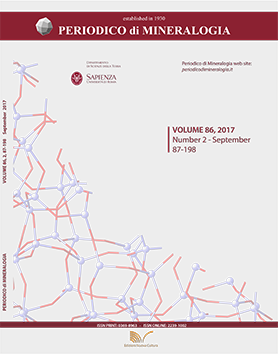The crystal structure of mineral fibres. 3. Actinolite asbestos
DOI:
https://doi.org/10.2451/2017PM714Keywords:
actinolite, amphibole asbestos, Rietveld, crystal structure, iron.Abstract
The present work reports chemical and structural data of actinolite asbestos from Aurina Valley, Bolzano (Italy). The chemical composition was determined using EMPA and TG analysis, and the Fe3+/Fetot ratio was accurately evaluated with independent 57Fe Mössbauer spectroscopy. Morphology and crystallinity were also investigated through SEM and TEM investigations. Crystal structure was refined using high-resolution synchrotron XRPD data. The iron content of Aurina Valley sample is lower compared to two representative asbestiform actinolite samples (with structure refinement) taken from the literature (FeOtot 7.77 wt% against 12÷13 wt%, respectively), accounting for the reduced cell volume here measured (910.29 Å. against 912÷918 Å., respectively). Refined site scattering values of Aurina Valley sample are in agreement with those calculated from chemical compositions, and the optimized structural formula is:
K0.02Na0.05(Na0.08Ca1.92)Ʃ=2.00(Mg3.80Fe2+0.79Fe3+0.11Al0.20Mn0.05Ni0.02Cr0.01)Ʃ= 4.98(Si7.67Al0.25)Ʃ=7.92O21.69(OH)2.31.
The C sites M(1), M(2) and M(3) are occupied by Mg and Fe in a proportion of ~4:1, whereas the M(4) site contains mainly Ca and a very small amount of Na. Iron exclusively occupies the octahedral C sites, with Fe2+ ions occurring at the M(1,2,3) sites and the small amount of Fe3+ (13% of Fetot) ordered at the M(2) site. The refined crystal structure and cation distribution are fully consistent with results previously obtained on asbestiform and non-asbestiform samples belonging to the tremolite-actinolite-ferro– actinolite substitutional series.


